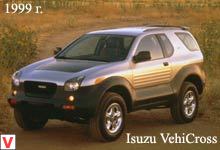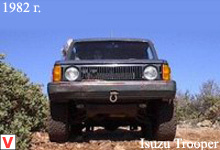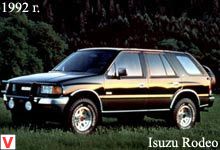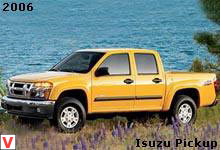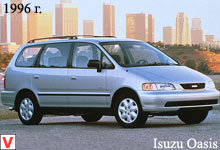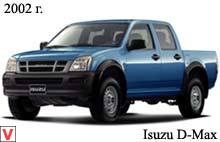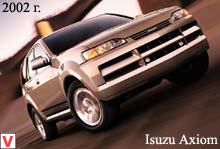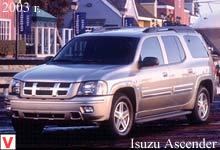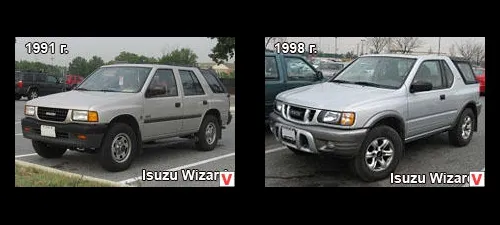
The Isuzu Wizard is a compact SUV produced by the Japanese car manufacturer Isuzu Motors Ltd. The appearance of the Isuzu Wizard car on the market was preceded by the Isuzu MU model. It came out in 1989 and was a three-door, relatively inexpensive SUV of the middle class.
The first generation Isuzu MU had a relatively small body length - 4 meters and a width of almost 1.8 meters. The cabin was equipped with two seats. Under the hood of the car was a four-cylinder SOHC engine with a volume of 2.6 liters.
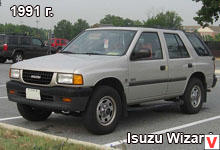
From the technical features of this model, you can select a five-speed manual gearbox and 4WD Part Time system (switching system between four-wheel drive (4WD) and front-wheel drive (2WD) and vice versa). Switching occurs while driving, depending on road conditions. Despite the good design and decent performance, This model did not gain much popularity, and a year later the modification “Metal Top”, equipped with four seats. Now a 2.8-liter turbocharged diesel engine and a 4-speed automatic gearbox fit under the hood.
This configuration was much more successful, and “MU” managed to achieve popularity as an SUV. The company did not stop there, and in 1991 a five-door version of the Isuzu MU was introduced, called the Isuzu MU Wizard. Then the car began to produce in other countries. In Europe, this model was named Rodeo, in the United States in the joint venture Subaru-Isuzu of America it became known as Amigo, in Great Britain - Vauxhall, but this, in fact, was already Opel. 8-liter turbocharged diesel engine and 4-speed automatic gearbox.
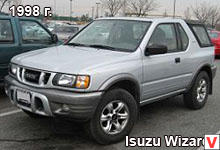
This configuration was much more successful, and “MU” managed to achieve popularity as an SUV. The company did not stop there, and in 1991 a five-door version of the Isuzu MU was introduced, called the Isuzu MU Wizard. Then the car began to produce in other countries. In Europe, this model was named Rodeo, in the United States in the joint venture Subaru-Isuzu of America it became known as Amigo, in Great Britain - Vauxhall, but this, in fact, was already Opel.
8-liter turbocharged diesel engine and 4-speed automatic gearbox. This configuration was much more successful, and “MU” managed to achieve popularity as an SUV. The company did not stop there, and in 1991 a five-door version of the Isuzu MU was introduced, called the Isuzu MU Wizard. Then the car began to produce in other countries.
In Europe, this model was named Rodeo, in the United States in the joint venture Subaru-Isuzu of America it became known as Amigo, in Great Britain - Vauxhall, but this, in fact, was already Opel. and in 1991, the five-door version of the Isuzu MU, called the Isuzu MU Wizard, was introduced. Then the car began to produce in other countries. In Europe, this model was named Rodeo, in the United States in the joint venture Subaru-Isuzu of America it became known as Amigo, in Great Britain - Vauxhall, but this, in fact, was already Opel.
and in 1991, the five-door version of the Isuzu MU, called the Isuzu MU Wizard, was introduced. Then the car began to produce in other countries. In Europe, this model was named Rodeo, in the United States in the joint venture Subaru-Isuzu of America it became known as Amigo, in Great Britain - Vauxhall, but this, in fact, was already Opel. In their homeland, Japan, the Isuzu Wizard is still being produced and is called “Jiangling Landwind”.
Initially, the cars were completed with three different engines: a four-cylinder petrol 4ZE1 with a volume of 2.6 liters, a diesel turbocharged 4JB1-T with a volume of 2.8 liters and an atmospheric 4JG2 with a volume of 3.1 liters. The export version of the Isuzu Wizard, which in Europe was called Isuzu Rodeo, was produced by the joint venture Subaru Automotive, located in India. 75 percent of the cars assembled at this plant were exported. The first car Isuzu Rodeo rolled off the assembly line in 1991.
The mid-size SUV had under its hood diesel turbocharged VM41B six-cylinder engine developed by General Motors volume 2.6 (120 hp), or 3.1 liters. The car was produced in three trim levels: S, XS, LS. All three versions had four-wheel drive, with the ability to switch the drive to the rear wheels, however, the S version was completed with a manual shutdown of the front-wheel drive, and the XS was automatic. Front disc and rear drum brakes were standard.
Thanks to the ability to transform the interior, that is, lay out the rear seat of the car, the trunk volume of the Isuzu Rodeo could be increased by 1 cu. meter, which is very significant. Isuzu Rodeo cars had a 83-liter fuel tank. Fuel consumption per 100 km.
depended on the car model and ranged from 10 to 13 liters for models with manual transmission and 13-15 liters for models with automatic gearbox. Car cost depended on a complete set: the S-version cost $ 12818, XS - $ 16600, LS with an automatic transmission - $ 17899 and $ 16799 with manual. The company sold 24,612 Rodeo cars in 1991 and 45,257 in 1992. In 1993, Isuzu replaced the General Motors engine with its own design - a 24-valve six-cylinder OHC engine with 2.7 liters. The power of such a power unit was 175 hp Updated Isuzu Rodeo became heavier than its predecessor. Its mass has changed from 1604 kg.
until 1869. In the 1993 models, the chassis was completely updated and the spring constant was changed. The cost of the car has increased to $ 14074 for the basic set. Fuel consumption per 100 km. rose to 18-21 liters. Later in 1993, a 3.2-liter engine appeared, and by 1996 it was possible to increase the power of this power unit to 195 hp. In 2004, Isuzu began producing cars with six-cylinder engines with direct fuel injection of 3.5 liters. The power of the new engine has increased to 250 hp It was the first car equipped with direct fuel injection, the price of which did not exceed $ 100,000.
In the US, the Rodeo car was so popular that its name can be found in the lyrics. For example, in 1997, Collin Raye’s song “Little Red Rodeo” appeared. It is about a man searching for his ex-girlfriend who drove Isuzu Rodeo. In 2004, Isuzu Rodeo was discontinued. In the United States, the Isuzu Wizard was called the Isuzu Amigo. For the first time this model was introduced in the USA in the spring of 1989. She was a compact all-wheel drive station wagon more sports-oriented than for any practical purposes. In the US, Amigo was sold both with four-wheel drive and rear-wheel drive.
The two-wheel drive models were completed with a four-cylinder engine of 2.3 liters, whose power was 96 horsepower. All-wheel drive models had a 2.6-liter engine under their hood. Both models worked on gasoline and were completed with a five-speed manual gearbox.
For the first Amigo, the choice of additional options was not very large: for an additional fee, the driver could get an air conditioner, two or four seats and two trim options. Over time, several small changes were made to the package and appearance of the car. In 1992, the standard was a 4-speed automatic transmission. In the same year, models with a 2.3-liter engine were discontinued and all cars began to be produced with a 2.6-liter engine. In 1994, brake lights, power steering and electrically adjustable exterior mirrors were added to the standard. Both models worked on gasoline and were completed with a five-speed manual gearbox.
For the first Amigo, the choice of additional options was not very large: for an additional fee, the driver could get an air conditioner, two or four seats and two trim options. Over time, several small changes were made to the package and appearance of the car. In 1992, the standard was a 4-speed automatic transmission. In the same year, models with a 2.3-liter engine were discontinued and all cars began to be produced with a 2.6-liter engine. In 1994, brake lights, power steering and electrically adjustable exterior mirrors were added to the standard. Both models worked on gasoline and were completed with a five-speed manual gearbox.
For the first Amigo, the choice of additional options was not very large: for an additional fee, the driver could get an air conditioner, two or four seats and two trim options. Over time, several small changes were made to the package and appearance of the car. In 1992, the standard was a 4-speed automatic transmission. In the same year, models with a 2.3-liter engine were discontinued and all cars began to be produced with a 2.6-liter engine. In 1994, brake lights, power steering and electrically adjustable exterior mirrors were added to the standard. for an additional fee, the driver could get air conditioning, two or four seats and two trim options.
Over time, several small changes were made to the package and appearance of the car. In 1992, the standard was a 4-speed automatic transmission. In the same year, models with a 2.3-liter engine were discontinued and all cars began to be produced with a 2.6-liter engine. In 1994, brake lights, power steering and electrically adjustable exterior mirrors were added to the standard.
for an additional fee, the driver could get air conditioning, two or four seats and two trim options. Over time, several small changes were made to the package and appearance of the car. In 1992, the standard was a 4-speed automatic transmission. In the same year, models with a 2.3-liter engine were discontinued and all cars began to be produced with a 2.6-liter engine.
In 1994, brake lights, power steering and electrically adjustable exterior mirrors were added to the standard. In the same year, models with a 2.3-liter engine were discontinued and all cars began to be produced with a 2.6-liter engine. In 1994, brake lights, power steering and electrically adjustable exterior mirrors were added to the standard. In the same year, models with a 2.3-liter engine were discontinued and all cars began to be produced with a 2.6-liter engine.
In 1994, brake lights, power steering and electrically adjustable exterior mirrors were added to the standard. In 1998, the second generation of Isuzu Amigo appeared. The car was completely changed - got a new body, a new frame, new engines. The gasoline four-cylinder engine X22SE with a volume of 2.2 liters (130 hp) or six-cylinder 6VD1 of the latest generation with a volume of 3.2 liters (205 hp) is located under the bonnet. The new “Amigo” received a convertible top, which is very similar to the Jeep Wrangler. The interior design of this car was almost completely copied from the interior of the Honda Passport.
Standard equipment included a folding rear seat, power windows, CD player, central locking. The Isuzu Amigo cabin could comfortably accommodate five people. In 1999, a rear-wheel drive version of the 3.2-liter Wizard was released. In addition, as a result of a series of changes in 2000, The Wizard has been completed with the 4WD FULLTIME (TOD) system and an improved suspension. In 2002, Amigo was renamed Rodeo Sport. In 2003, the Amigo model was discontinued.
In the UK, the Wizard was known as Vauxhall Frontera and Opel Frontera. It was originally assembled at the Bedford Vehicles plant in Luton, which was later renamed IBC (Isuzu Bedford Company). In 1980, the factory came under the joint management of Isuzu and General Motors due to the merger of these two companies. By 1998, General Motors gained full control of the IBC Vehicles factory and Opel Frontera production was transferred to the General Motors Vauxhall plant in Ellesmere-Port.
"Frontera" was taken off the assembly line in 2004. It is planned to replace cars Vauxhall models based on GM Daewoo / Chevrolet Captiva, and not on the Isuzu model. In Australia and New Zealand, the Frontera has already been replaced by the renamed GM version of Daewoo / Chevrolet Captiva. Currently, Isuzu, in accordance with increased market demand, is successfully developing diesel engines with improved environmental parameters.
